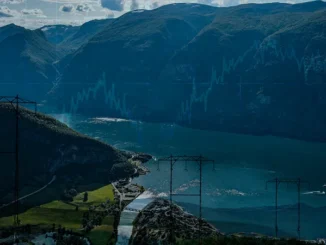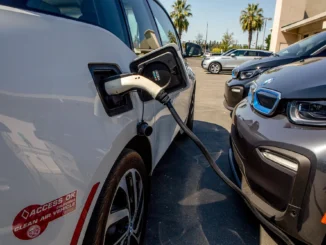
Check out the latest energy crisis hobbling California: Smoke from fires triggered by an extended drought is obscuring the sunlight needed to power solar panels.
But, at the same time, a tropical storm is generating rain and clouds, which are also hampering solar generation. Shouldn’t the storm be dousing the fires?
Renewable energy, it turns out, is not only unreliable; it’s downright confusing.
What else can go wrong in the Golden State? In a word, plenty. California is suffering an energy catastrophe that is almost entirely self-inflicted. Bad policies (including decades of sloppy forest management) have exacerbated the impact of a dire drought, while green mania has stripped the state of the kinds of back-up solutions that are critical to shifting to renewable energy.
The astonishing thing is that policymakers here in the U.S. will learn nothing from the California’s travails. In fact, in a trip to the Golden State just days before officials warned citizens of impending energy blackouts, Energy Secretary Jennifer Granholm gushed to an interviewer, “California is in the lead and can show the rest of the nation how it is done.”
Let us sincerely hope not.
Here is what California is actually showing the nation:
- Renewable energy from solar and wind power is unreliable and must be back-stopped by steady nuclear or fossil-fuel facilities;
- Energy independence is energy security;
- Forcing an accelerated transition to renewable energy can put lives and economies at risk.
We should have learned the same lessons from the ongoing energy crisis in Europe, which began way before Putin invaded Ukraine and which stems from many of the same “rush to green” mistakes being made on the West coast. But the climate zealots in Biden’s White House are unmoved.
Granholm visited California just before Gov. Newsom asked residents to turn up their thermostats to 78 degrees and refrain from charging their electric vehicles (EVs) between the hours of 4 p.m. and 9 p.m. EVs that, as it happened, the state recently mandated would be the only kind of car sold in California by 2035.
Granholm waxed positively giddy over what she saw. “I love the fact that California is unabashedly bold about [green] energy policy,” she enthused, adding “California’s boldness has … shaped our willingness in the federal government to move further and faster.”
One wonders what part of California’s energy solutions Granholm admires. Is it that homeowners pay 88 percent more for electricity than Americans elsewhere? Or that industrial users are being charged 99 percent more than their competitors in other states?
Maybe she’s envious that Californians pay 43 percent more than the national average for gasoline today or that natural gas for heating homes in Los Angeles costs 23 percent more than in the rest of the country.
Surely California residents are not happy with those comparisons. Especially low-income residents, for whom the costs of basic items such as rent and energy comprise a larger-than-average share of their monthly budget.
They cannot be happy, too, that officials threaten power outages when the temperature hits 115 degrees in parts of the state; people could die.
Granholm, like Democrats elsewhere, talks a lot about energy “equity.” But there’s nothing equitable about paying hugely inflated electricity costs to provide leftwing politicians with spiffy climate credentials.
Why is California in its current fix?
Start with the obvious, on the supply side. The Golden State boasts some of the nation’s largest oil and gas reserves but chooses not to produce them for environmental reasons. California’s oil reserves rank fifth in the U.S, but California imports some 1.4 million barrels per day of oil, while producing only 400,000 barrels a day.
The climate warriors in the state, while shutting down local production, have also blocked construction of new pipelines. Even though the state has chosen to import 70 percent of the oil it consumes, there are no pipelines available to access the commodity (at possibly lower prices) from other states. Shipping oil via trucks or rail is of course not acceptable, for environmental reasons.
Ironically, the state is importing oil from countries such as Ecuador, Iraq and Saudi Arabia — countries with much more lenient environmental regulations that the U.S.
Also, the state has been shutting down natural gas and nuclear power plants, even though the latter are emissions-free and presumably could help California reach its 2045 zero-carbon goal.
Responding to the latest crisis, officials decided to bring several gas-fired generators online and give Diablo Canyon, a critical nuclear plant that is the state’s single biggest source of electricity, a stay of execution. It had been scheduled to be shut down by 2025. But the Democrat-run state legislature acknowledged in a rare moment of clarity that turning off the lights and air conditioning in the middle of a record heat wave might finally rouse abused voters from their torpor.
Diablo Canyon not only provides 9 percent of the state’s electricity, it also generates 15 percent of California’s clean energy.
Officials are rushing to electrify California, mandating a switch not only to EVs but also to electric appliances. Simply said, the infrastructure necessary to accommodate the massive expansion of demand is not in place. There have already been occasional blackouts over the past two years at moments of stress. With demand from EVs increasing, those outages will likely increase.
In comments contesting the EV mandates, the Western States Petroleum Association wrote in a statement, “electrification of the transportation sector will increase demand by around 300,000 gigawatt-hours statewide.” That translates into a doubling of electricity demands.
Our nation may choose to transition to renewable energy, despite the negligible impact our efforts will likely have on the Earth’s climate. (The actions of China and India will prove far more consequential.) But to make such a move hastily and without adequate contingencies not only sacrifices one of our greatest geopolitical advantages but threatens our economy and – yes – endangers lives.
Let California not be our guide.



